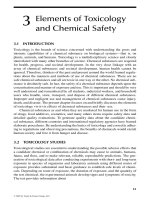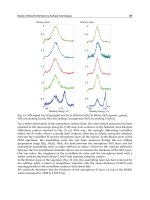GSM Networks : Protocols, Terminology, and Implementation - Chapter 3 pot
Bạn đang xem bản rút gọn của tài liệu. Xem và tải ngay bản đầy đủ của tài liệu tại đây (410.31 KB, 12 trang )
3
The Base Station Subsystem
Via the Air-interface, the BSS provides a connection between the MSs of a lim-
ited area and the network switching subsystem (NSS). The BSS consists of the
following elements:
• One or more BTSs (base tranceiver station);
• One BSC (base station controller);
• One TRAU (transcoding rate and adaptation unit).
The tasks and the structure of those elements or modules are described in this
chapter.
3.1 Base Transceiver Station
The BTS provides the physical connection of an MS to the network in form of
the Air-interface. On the other side, toward the NSS, the BTS is connected to
the BSC via the Abis-interface.
The manufacturers of BTS equipment have been able to reduce its size
substantially. The typical size in 1991 was that of an armoire; today the size is
comparable to that of a mailbox. The basic structure of the BTS, however, has
not changed. The block diagram and the signal flow of a BTS with one TRX
are shown in Figure 3.1. The GSM Recommendations allow for one BTS to
host up to 16 TRXs. In the field, the majority of the BTSs host between one
and four TRXs.
19
3.1.1 Architecture and Functionality of a Base Transceiver Station
3.1.1.1 Transmitter/Receiver Module
The TRX module is, from the perspective of signal processing, the most impor-
tant part of a BTS. The TRX consists of a low-frequency part for digital signal
processing and a high-frequency part for GMSK modulation and demodula-
tion. Both parts are connected via a separate or an integrated frequency hop-
ping unit. All other parts of the BTS are more or less associated with the TRXs
and perform auxiliary or administrative tasks.
A TRX with integrated frequency hopping serves the tasks listed in
Table 3.1.
3.1.1.2 Operations and Maintenance Module
The operations and maintenance (O&M) module consists of at least one cen-
tral unit, which administers all other parts of the BTS. For those purposes, it is
connected directly to the BSC by means of a specifically assigned O&M chan-
nel. That allows the O&M module to process the commands from the BSC or
the MSC directly into the BTS and to report the results. Typically, the central
unit also contains the system and operations software of the TRXs. That allows
it to be reloaded when necessary, without the need to “consult” the BSC.
Furthermore, the O&M module provides a human-machine interface (HMI),
which allows for local control of the BTS.
20 GSM Networks: Protocols, Terminology, and Implementation
Output
filter
Diversity
Input
filter
HF transmitter
(HF-TX)
HF receiver
(HF-RX)
Slow frequency
hopping
TRX
Digital
signal processing
(NF functionality)
Transmission
system
O&M module Operation and maintenance functionality/clock distribution
Abis-
interface
Air-interface
Figure 3.1 Block diagram of a BTS with one TRX.
3.1.1.3 Clock Module
The modules for clock generation and distribution also are part of the O&M
area. Although the trend is to derive the reference clock from the PCM signal
on the Abis-interface, a BTS internal clock generation is mandatory. It is espe-
cially needed when a BTS has to be tested in a standalone environment, that is,
without a connection to a BSC or when the PCM clock is not available due to
link failure.
Still, there is a cost savings benefit in the approach of deriving the clock
from the PCM signal. By doing so, much cheaper internal clock generators can
be applied, because they do not require the same long-term stability as an inde-
pendent clock generator. Besides, there is no need for frequent maintenance
checks on the clock modules, since they synchronize themselves with the clock
coming from the PCM link.
When analyzing errors in call handling, particularly in the area of hando-
ver, even minor deviations from the clock have to be considered as possible
The Base Station Subsystem 21
Table 3.1
Tasks of a TRX With Integrated Frequency Hopping
Function LF HF
Channel coding and decoding ●
Interleaving and ordering again ●
Encryption and decryption (ciphering) ●
Slow frequency hopping ●
Burst formatting ●
TRAU frame formatting and conversion in direction to/from the BSC, setup
of the LAPD connection to the BSC
●
GMSK modulation of all downlink data ●●
GMSK demodulation of all received MS signals ●●
Creation and transmission of the broadcast common control channel (BCCH)
on channel 0 of the BCCH-TRX
●●
Measurement of signal strength and quality for active connections ●●
Provision of the results to the BSC (MEAS_RES message)
Interference measurements (idle channel measurements) on free channels
and forwarding of the results to the BSC in a RF_RES_IND message
●●
LF = low frequency part of the TRX; HF = high frequency part of the TRX.
causes for errors. GSM requires that all the TRXs of a BTS use the same clock
signal. The accuracy of the signal has to have a precision of at least 0.05 parts
per million (ppm). For example, a clock generator that derives the clock from a
10 MHz signal has to be able to provide a clock with a frequency accuracy of
10 MHz ±0.5 Hz (10 ⋅ 10
6
Hz ⋅ 0.05 ⋅ 10
−6
= 0.5 Hz).
3.1.1.4 Input and Output Filters
Both input and output filters are used to limit the bandwidth of the received
and the transmitted signals. The input filter typically is a nonadjustable wide-
band filter that lets pass all GSM 900, all DCS 1800, or all PCS 1900 frequen-
cies in the uplink direction. In contrast, remote-controllable filters or wideband
filters are used for the downlink direction that limits the bandwidth of the out-
put signal to 200 kHz. When necessary, the O&M center (OMC) controls the
settings of the filters, as in the case of a change in frequency.
3.1.2 Base Transceiver Station Configurations
Different BTS configurations, depending on load, subscriber behavior, and
morph structure, have to be considered to provide optimum radio coverage of
an area. The most important BTS configurations of a BTS are presented next.
3.1.2.1 Standard Configuration
All BTSs are assigned different cell identities (CIs). A number of BTSs (in some
cases, a single BTS) form a location area. Figure 3.2 shows three location areas
with one, three, and five BTSs. The systems are usually not fine-synchronized
(see synchronized handover in the Glossary), which prevents synchronized han-
dover between them. That method of implementing BTSs is the one most fre-
quently used. For urban areas with growing traffic density, that may change
soon. For this situation, the configurations described in Sections 3.1.2.2 and
3.1.2.3 are more appropriate.
3.1.2.2 Umbrella Cell Configuration
The umbrella cell configuration consists of one BTS with high transmission
power and an antenna installed high above the ground that serves as an
“umbrella” for a number of BTSs with low transmission power and small
diameters (Figure 3.3).
Such a configuration appears to make no sense at first, because the fre-
quency of the umbrella cell can not be reused in all the cells of that area due to
interference. Interference even over a large distance was one of the reasons why
the high radio and television towers were abandoned as sites for antennas
shortly after they were brought into service at the initial network startup.
22 GSM Networks: Protocols, Terminology, and Implementation
The Base Station Subsystem 23
300 m–35 km
BTS
TRX
BTS
TRX
BTS
TRX
BTS
TRX
BTS
TRX
BTS
TRX
BTS
TRX
BTS
TRX
Figure 3.2 BTSs in standard configuration.
BTS
TRX
BTS
TRX
BTS
TRX
BTS
TRX
BTS
TRX
BTS
TRX
Figure 3.3 Umbrella cell with five smaller cells.
The umbrella cell configuration still has its merits in certain situations
and therefore may result in relief from load and an improvement of the net-
work. For example, when cars are moving at rather high speeds through a net-
work of small cells, almost consecutive handovers from one cell to the next are
necessary to maintain an active call. This situation is applicable in every urban
environment that features city highways. Consequently, the handovers result
in a substantial increase of the signaling load for the network as well as in an
unbearable signal quality degradation for the end user. On the other hand,
small cells are required to cope with the coverage demand in an urban
environment.
The way out of this dilemma is to use both large and small cells at the
same time, that is, the umbrella cell configuration. The umbrella cell can be
protected from overload when traffic from only fast-moving users is assigned to
it. This, on the other hand, reduces the signaling load of the small cells and
improves the signal quality for the fast-moving traffic. The speed of a user
can be determined to sufficient accuracy by the change of the timing advance
(TA) parameter. Its value is updated in the BSC every 480 milliseconds (ms)
by means of the data provided in the MEAS_RES message. The BSC decides
whether to use the umbrella cell or one of the small cells. GSM has not speci-
fied the umbrella cell configuration, which requires additional functionality in
the BSC, a manufacturer’s proprietary function.
3.1.2.3 Sectorized (Collocated) Base Transceiver Stations
The term sectorized, or collocated, BTSs refers to a configuration in which
several BTSs are collocated at one site but their antennas cover only an area
of 120 or 180 degrees. Figure 3.4 illustrates the concept. Typically, it is
implemented with BTSs with few TRXs and low transmission power. Like the
umbrella cell configuration, this configuration is used mostly in highly popu-
lated areas. A peculiarity is that it is fairly easy to fine-synchronize the cells with
each other, which allows for synchronized handover between them. Even
though in a collocated configuration, one channel per BTS has to be used for
the generation of the BCCH, such a configuration has the following
advantages:
•
Sectorized, or collocated, BTSs are well suited for a serial connection
of the Abis-interface (discussed in detail in Chapter 6). This configura-
tion has the potential to save costs for access lines to the BSC. Other-
wise, multiple sites require multiple (leased) lines.
•
From the radio perspective, the advantage of using cells with a
120-degree angle is that it allows reuse of frequencies in one sector
24 GSM Networks: Protocols, Terminology, and Implementation
(one direction), which otherwise would cause interference with neigh-
bor cells if an omnidirectional cell were used.
•
Sectorization eases the demand for frequencies, particularly in an
urban environment.
3.2 Base Station Controller
The BSC forms the center of the BSS. A BSC can, depending on the manufac-
turer, connect to many BTSs over the Abis-interface. The BSC is, from a tech-
nical perspective, a small digital exchange with some mobile-specific
extensions. The BSC was defined with the intention of removing most of the
radio-related load from the MSC. The BSC’s architecture and its tasks are a
The Base Station Subsystem 25
120 sector° 120 sector°
120 sector°
BTS
TRX
BTS
TRX
BTS
TRX
Figure 3.4 Coverage of an area with three sectorized BTSs. Each BTS covers a segment of
120 degrees.
consequence of that goal. For simplicity, Figure 3.5 uses the same hardware for
both the Abis-interface and the A-interface, which is not a requirement.
3.2.1 Architecture and Tasks of the Base Station Controller
3.2.1.1 Switch Matrix
Because the BSC has the functionality of a small digital exchange, its function
is to switch the incoming traffic channels (A-interface from the MSC) to the
correct Abis-interface channels. The BSC, therefore, comes with a switch
matrix that (1) takes care of the relay functionality and (2) can be used as the
internal control bus.
3.2.1.2 Terminal Control Elements of the Abis-Interface
The connection to the BTSs is established via the Abis-terminal control ele-
ments (TCEs), which, more or less independently from the BSC’s central unit,
provide the control function for a TRX or a BTS. The number of Abis TCEs
that a BSC may contain depends largely on the number of BTSs and on the sys-
tem manufacturer.
Major tasks of the Abis-TCEs are to set up LAPD connections toward the
BTS peers, the transfer of signaling data, and last—but not least—the transpar-
ent transfer of payload.
Depending on the manufacturer, the Abis TCEs also may be responsible
for the administration of BTS radio resources. That entails the assignment and
26 GSM Networks: Protocols, Terminology, and Implementation
TM TCE
TM TCE
TM TCE
Switch
matrix
TMTCE
TMTCE
TMTCE
DB
Central module Central functions, clock distribution
OMC
A-interface
Abis-interface
Figure 3.5 Block diagram of a BSC.
release of signaling and traffic channels over the Abis-interface and the Air-
interface and for the evaluation of measurement results from the BTS concern-
ing busy and idle channels, which are relevant for power control and used in
making decisions about handovers. The final control functionality always
remains with the BSC, although GSM explicitly allows the BTS to preprocess
the measurement results. Depending on the manufacturer, those functions also
can be assumed or controlled by a central unit.
Connections from the Abis TCEs to the A-TCEs are realized by the
switch matrix. On the other side, the PCM connections are achieved by associ-
ated transmission elements.
3.2.1.3 A-Interface Terminal Control Elements
The connection of a BSC to the MSC is established via the A-TCEs. Although
every BSC is connected to only one MSC, a large number of A-TCEs is needed
to support the A-interface, since all the payload and the major part of the sig-
naling data of the entire BSS have to be conveyed over this interface.
Among the tasks of some, but usually not all A-TCEs is setting up and
operating the SS7/SCCP connection toward the MSC. The number of neces-
sary signaling channels depends largely on the predicted traffic load (see also
Chapter 10).
3.2.1.4 Database
The BSC is the control center of the BSS. In that capacity, the BSC must main-
tain a relatively large database in which the maintenance status of the whole
BSS, the quality of the radio resources and terrestrial resources, and so on are
dynamically administrated. Furthermore, the BSC database contains the com-
plete BTS operations software for all attached BTSs and all BSS specific infor-
mation, such as assigned frequencies.
3.2.1.5 Central Module
One of the major tasks of the BSC is to decide when a handover should take
place. The BSC may decide on intra-BTS handover and intra-BSC handover
without needing the MSC. In contrast, for all BSC external handovers, the
BSC needs to involve the MSC. Handover decision and power control are
main tasks of the central module.
3.2.1.6 Connection to the OMC
Another functionality that many manufacturers have decided the central mod-
ule should perform is the connection to the OMC. Every BSS is supervised and
managed by an OMC via the BSC.
The Base Station Subsystem 27
3.3 Transcoding Rate and Adaptation Unit
3.3.1 Function of the Transcoding Rate and Adaptation Unit
One of the most interesting functions in GSM involves the TRAU, which typi-
cally is located between the BSC and the MSC. The task of the TRAU is to
compress or decompress speech between the MS and the TRAU. The used
method is called regular pulse excitation–long term prediction (RPE-LTP). It is
able to compress speech from 64 Kbps to 16 Kbps, in the case of a fullrate
channel (net bit rate with fullrate is 13 Kbps) and to 8 Kbps in the case of a hal-
frate channel (net bit rate with halfrate is 6.5 Kbps).
Note that the TRAU is not used for data connections.
3.3.2 Site Selection for Transcoding Rate and Adaptation Unit
Although speech compression is intended mainly to save resources over the
Air-interface, it also is suitable to save line costs when applied on terrestrial
links, as illustrated schematically in Figure 3.6. When the TRAU is installed at
the MSC site (see top portion of Figure 3.6), a fullrate speech channel uses only
16 Kbps over the link from the BSC to the MSC.
The specifications allow for the installation of the TRAU between the
BTS and the BSC. That requires, however, the use of 64-Kbps channels
between the BSC and the MSC and hence the use of more links (see bottom
portion of Figure 3.6).
This variant is, therefore, used only infrequently. In fact, most of the
time, the TRAU is installed at the site of the MSC to get the most benefit from
the compression.
28 GSM Networks: Protocols, Terminology, and Implementation
MSC
BSC
TRAU frame
16 Kbit/s16 Kbit/s
16 Kbit/s
16 Kbit/s
16 Kbit/s
64 Kbit/s 64 Kbit/s
64 Kbit/s
TRAU
TRAU
TRAU
frame
BTS
TRX
BTS
TRX
BSC
MSC
Figure 3.6 Possible sites for the TRAU in the signal chain.
3.3.3 Relationship Between the Transcoding Rate and Adaptation Unit,
and Base Station Subsystem
The TRAU is functionally assigned to the BSS, independently of where it actu-
ally is located. The reason for that is the following.
Both the BTS and the TRAU have an interface for payload that is trans-
parent for the BSC. The payload is formatted in TRAU frames, then transpar-
ently sent over PCM links between the TRAU and the BTS in cycles of 20 ms.
That applies to both directions. The data contained in the TRAU frames form
the input and output values for channel coding.
For data connections, the compression functionality has to be switched
off. The type of connection (data/speech) is communicated to the TRAU
during the assignment of the traffic channel. As illustrated in Figure 3.7, the
BTS starts to transmit TRAU frames in the uplink, immediately after receiving
the CHAN_ACT message. Those TRAU frames carry inband signaling, which
is exchanged between the BTS-TRX (or more precisely the coding unit) and
the TRAU, to consolidate the characteristics of a connection. Part of the con-
trol information is, in particular, synchronization data, discontinuous transmis-
sion (DTX) on/off, and the connection type (halfrate/fullrate).
The Base Station Subsystem 29
Air-interface Abis-interface A-interface
DT1/BSSM
ASS_REQ [A-Itf chann.]
I/DCM/CHAN_ACT
[Fullrate/Halfrate/DTX]
I/DCM/
CHAN_ACT_ACK [FN]
TRAU
20 ms
TRAU
20 ms
TRAU
I/RLM/DATA_REQ
ASS_CMD [TCH-Data]
SDCCH/I/RR
ASS_CMD [TCH-Data]
BTS
TRX
MSC
VLR
BSC
TRAU-Frame (activation of the TRAU)
TRAU-Frame (activation of the TRAU)
TRAU-Frame (activation of the TRAU)
Figure 3.7 Activation of the TRAU during assignment of a traffic channel.
Note that TRAU frames are sent over traffic channels and not over the
associated control channels and hence are transparent to protocol analysis.
The TRAU frames are, nevertheless, very important for error analysis on data
connections.
30 GSM Networks: Protocols, Terminology, and Implementation









